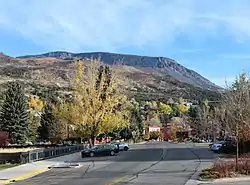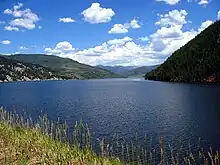Basalt, Colorado | |
|---|---|
 Downtown Basalt with Basalt Mountain in the background | |
| Nickname: "The Heart of the Roaring Fork Valley" | |
 | |
 Basalt Location of the Town of Basalt in the United States. | |
| Coordinates: 39°22′08″N 107°01′50″W / 39.36889°N 107.03056°W[2] | |
| Country | |
| State | |
| Counties | Eagle County[1] Pitkin County |
| Incorporated | August 26, 1901[3] |
| Government | |
| • Type | Home rule municipality[1] |
| • Mayor | Bill Kane |
| Area | |
| • Total | 1.999 sq mi (5.178 km2) |
| • Land | 1.992 sq mi (5.158 km2) |
| • Water | 0.008 sq mi (0.020 km2) |
| Elevation | 6,611 ft (2,015 m) |
| Population | |
| • Total | 3,984 |
| • Density | 2,000/sq mi (800/km2) |
| • CSA | 134,774 |
| Time zone | UTC−07:00 (MST) |
| • Summer (DST) | UTC−06:00 (MDT) |
| ZIP code | 81621[5] |
| Area code | 970 |
| FIPS code | 08-04935 |
| GNIS feature ID | 2411665[2] |
| Highways | |
| Website | www |
Basalt is a home rule municipality located in Eagle and Pitkin counties, Colorado, United States.[6] The town population was 3,984 at the 2020 United States Census with 2,917 residing in Eagle County and 1,067 residing in Pitkin County.[4] Basalt is a part of the Edwards-Glenwood Springs, CO Combined Statistical Area.
History
Basalt was first named Aspen Junction after the railroad junction which led to present day Aspen, Colorado. Aspen Junction was a territory serving Aspen to Leadville Mining towns, with the Railroad Junction, also going West and South to Carbondale and Glenwood Springs. It was first served by the Colorado Midland Railroad, it was later bought out in 1901 by the Denver & Rio Grande Railroad.[7][8]
The town was named for the basaltic rock formation on Basalt Mountain, and began as a railroad town.[9] The town was incorporated in 1901.
Geography
Basalt is located along State Highway 82, and at the confluence of the Fryingpan and Roaring Fork rivers.
At the 2020 United States Census, the town had a total area of 1,280 acres (5.178 km2) including 4.9 acres (0.020 km2) of water.[4]
Demographics
| Census | Pop. | Note | %± |
|---|---|---|---|
| 1900 | 382 | — | |
| 1910 | 235 | −38.5% | |
| 1920 | 185 | −21.3% | |
| 1930 | 148 | −20.0% | |
| 1940 | 212 | 43.2% | |
| 1950 | 173 | −18.4% | |
| 1960 | 213 | 23.1% | |
| 1970 | 419 | 96.7% | |
| 1980 | 529 | 26.3% | |
| 1990 | 1,128 | 113.2% | |
| 2000 | 2,681 | 137.7% | |
| 2010 | 3,857 | 43.9% | |
| 2020 | 3,984 | 3.3% | |
| U.S. Decennial Census | |||
As of the census[10] of 2000, there were 2,681 people, 1,052 households, and 637 families residing in the town. The population density was 1,394.8 inhabitants per square mile (538.5/km2). There were 1,218 housing units at an average density of 633.7 per square mile (244.7/km2). The racial makeup of the town was 91.53% White, 0.48% African American, 0.52% Native American, 1.27% Asian, 0.11% Pacific Islander, 4.77% from other races, and 1.31% from two or more races. Hispanic or Latino of any race were 11.75% of the population.
There were 1,052 households, out of which 34.0% had children under the age of 18 living with them, 50.1% were married couples living together, 7.4% had a female householder with no husband present, and 39.4% were non-families. 24.0% of all households were made up of individuals, and 2.0% had someone living alone who was 65 years of age or older. The average household size was 2.55 and the average family size was 3.00.
In the town, the population was spread out, with 23.6% under the age of 18, 6.8% from 18 to 24, 42.3% from 25 to 44, 24.4% from 45 to 64, and 3.0% who were 65 years of age or older. The median age was 34 years. For every 100 females, there were 108.8 males. For every 100 females age 18 and over, there were 110.6 males.
The median income for a household in the town was $67,200, and the median income for a family was $73,375. Males had a median income of $40,791 versus $30,532 for females. The per capita income for the town was $30,746. About 4.9% of families and 6.3% of the population were below the poverty line, including 5.9% of those under age 18 and 6.8% of those age 65 or over.

Tourism
Basalt is well known for its Gold Medal trout fishing in the Frying Pan River. Ruedi Reservoir is also a popular regional destination for boating and other watersports. Basalt is a hub for mountain biking in the Roaring Fork valley. There are a dozen world class cross country trails as well as lift-accessed downhilling within 15 miles of Basalt, both up and down the valley.
Transportation
- Roaring Fork Transportation Authority (RFTA) provides bus transit in Basalt.
- Basalt's public transit system (WE-CYCLE) supplied by PBSC.
Notable people
- Wally Dallenbach Jr., NASCAR driver
- Neil Diamond, musician
- Joey Diaz, comedian
- Hanna Faulhaber, freestyle skier and Olympian
- Ann Korologos, former United States Secretary of Labor
- Tom Korologos, former United States Ambassador to Belgium
- Christy Smith, contestant on Survivor: The Amazon
- Torin Yater-Wallace, Olympian freestyle skier
See also
References
- 1 2 3 "Active Colorado Municipalities". Colorado Department of Local Affairs. Retrieved October 15, 2021.
- 1 2 3 U.S. Geological Survey Geographic Names Information System: Basalt, Colorado
- ↑ "Colorado Municipal Incorporations". State of Colorado, Department of Personnel & Administration, Colorado State Archives. December 1, 2004. Archived from the original on September 27, 2007. Retrieved August 18, 2007.
- 1 2 3 4 "Decennial Census P.L. 94-171 Redistricting Data". United States Census Bureau, United States Department of Commerce. August 12, 2021. Retrieved September 7, 2021.
- ↑ "ZIP Code Lookup". United States Postal Service. August 19, 2007. Archived from the original (JavaScript/HTML) on August 18, 2007. Retrieved August 19, 2007.
- ↑ "Active Colorado Municipalities | Colorado Department of Local Affairs". dola.colorado.gov. Retrieved September 21, 2020.
- ↑ "History of Basalt | Basalt, CO - Official Website". www.basalt.net. Retrieved February 19, 2020.
- ↑ "History of Basalt, Colorado". Basalt Mountain Inn. Retrieved February 19, 2020.
- ↑ "Welcome to Basalt, Colorado". Town of Basalt. Archived from the original on March 9, 2012. Retrieved March 7, 2012.
- ↑ "U.S. Census website". United States Census Bureau. Retrieved January 31, 2008.


